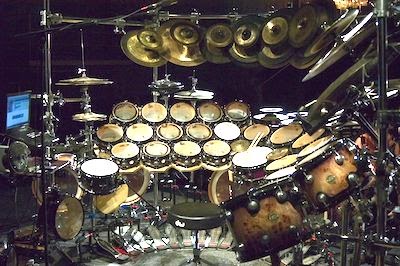Here's an excerpt from my Audio Mixing Bootcamp book that shows some basic EQ points for each drum and cymbal. Although these points may change slightly depending upon the drum kit, drummer, tuning, arrangement and song, they're pretty much in the ballpark. Just remember that you usually don't need a lot of EQ to make a difference on a well-recorded kit.
"The drums present an interesting dilemma - does the song demand that the drum kit works as a whole, or should the snare or kick stand out? Once again, it depends upon the song, but we can take a look at both approaches.
The kick and snare are extremely important in modern music because the kick is the heartbeat and the snare drives the song. By simply getting the sound and balance of these two drums right, it’s possible to change a song from dull to exciting.
There are certain frequencies on different drums that you should be aware of.
Kick - Girth at 50Hz and below, bottom at 80 to 100Hz, hollowness at 200 to 400Hz, point at 3k to 5kHz
Snare - Fatness at 120 to 240Hz, point at 900Hz to 2kHz, crispness at 5kHz, snap at 10kHz
Hat - Clang at 200Hz, sparkle at 8k to 10kHz
Rack Toms - Fullness at 240 to 500Hz, attack at 5k to 7kHz
Floor Tom - Fullness at 80Hz, attack at 5kHz
Cymbals - Clang at 200Hz, sparkle at 8k to 10kHz
These frequencies are not cut and dried for each drum kit, since the size of the drum or cymbal and the material they’re made of contributes greatly to the tone. Remember to sweep the frequencies around each of the above to find the correct frequency for that particular drum or cymbal.
Beware that boosting from 40 to 60Hz too much may make the kick sound big on your speakers, but it might not be heard when played back on smaller speakers. Also remember that the ideal spot for a 22 inch kick drum (which is the most commonly used) is around 80Hz."
To read additional excerpts from The Audio Mixing Bootcamp book and my other books, go to the excerpts section of bobbyowsinski.com. You also might want to check out my Audio Mixing Bootcamp video series on Lynda.com.



1 comment:
Bobby, I really appreciate your tips. I've watched your courses on Lynda.com and have your book on mastering in T-Racks and I feel like you really make things easy to understand for people on all skill levels. I've been writing and recording for years, but I always find some interesting tid bit to walk away with. The paragraph in this article describing the drum frequencies is a perfect example of that. Thanks for sharing your experience with us.
Post a Comment